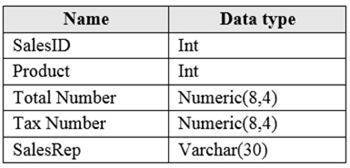- (Exam Topic 5)
Note: This question is part of a series of questions that present the same scenario. Each question in the series contains a unique solution that might meet the stated goals. Some question sets might have more than one correct solution, while others might not have a correct solution.
After you answer a question in this section, you will NOT be able to return to it. As a result, these questions will not appear in the review screen.
You have an Azure SQL database named Sales.
You need to implement disaster recovery for Sales to meet the following requirements:  During normal operations, provide at least two readable copies of Sales.
During normal operations, provide at least two readable copies of Sales. Ensure that Sales remains available if a datacenter fails.
Ensure that Sales remains available if a datacenter fails.
Solution: You deploy an Azure SQL database that uses the General Purpose service tier and geo-replication. Does this meet the goal?
Correct Answer:
B
Instead deploy an Azure SQL database that uses the Business Critical service tier and Availability Zones. Note: Premium and Business Critical service tiers leverage the Premium availability model, which integrates compute resources (sqlservr.exe process) and storage (locally attached SSD) on a single node. High availability is achieved by replicating both compute and storage to additional nodes creating a three to four-node cluster.
By default, the cluster of nodes for the premium availability model is created in the same datacenter. With the introduction of Azure Availability Zones, SQL Database can place different replicas of the Business Critical database to different availability zones in the same region. To eliminate a single point of failure, the control ring is also duplicated across multiple zones as three gateway rings (GW).
Reference:
https://docs.microsoft.com/en-us/azure/azure-sql/database/high-availability-sla
- (Exam Topic 1)
You need to implement the monitoring of SalesSQLDb1. The solution must meet the technical requirements.
How should you collect and stream metrics? To answer, select the appropriate options in the answer area.
NOTE: Each correct selection is worth one point.
Solution:
Box 1: The server, the elastic pool, and the database Senario:
SalesSQLDb1 is in an elastic pool named SalesSQLDb1Pool.
Litware technical requirements include: all SQL Server and Azure SQL Database metrics related to CPU and storage usage and limits must be analyzed by using Azure built-in functionality.
Box 2: Azure Event hubs
Scenario: Migrate ManufacturingSQLDb1 to the Azure virtual machine platform. Event hubs are able to handle custom metrics.
Does this meet the goal?
Correct Answer:
A
- (Exam Topic 5)
You have an Azure Data Factory pipeline that performs an incremental load of source data to an Azure Data Lake Storage Gen2 account.
Data to be loaded is identified by a column named LastUpdatedDate in the source table. You plan to execute the pipeline every four hours.
You need to ensure that the pipeline execution meets the following requirements:
Automatically retries the execution when the pipeline run fails due to concurrency or throttling limits. Supports backfilling existing data in the table.
Which type of trigger should you use?
Correct Answer:
A
The Tumbling window trigger supports backfill scenarios. Pipeline runs can be scheduled for windows in the past.
Reference:
https://docs.microsoft.com/en-us/azure/data-factory/concepts-pipeline-execution-triggers
- (Exam Topic 5)
You have an Azure SQL database that contains a table named factSales. FactSales contains the columns shown in the following table.
FactSales has 6 billion rows and is loaded nightly by using a batch process.
Which type of compression provides the greatest space reduction for the database?
Correct Answer:
D
Columnstore tables and indexes are always stored with columnstore compression. You can further reduce the size of columnstore data by configuring an additional compression called archival compression.
Note: Columnstore — The columnstore index is also logically organized as a table with rows and columns, but the data is physically stored in a column-wise data format.
Reference:
https://docs.microsoft.com/en-us/sql/relational-databases/data-compression/data-compression
- (Exam Topic 5)
You have an Azure SQL managed instance that hosts multiple databases.
You need to configure alerts for each database based on the diagnostics telemetry of the database. What should you use?
Correct Answer:
D
Reference:
https://docs.microsoft.com/en-us/azure/azure-sql/database/metrics-diagnostic-telemetry-logging-streaming-expo

